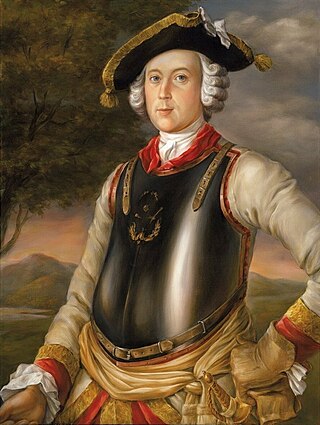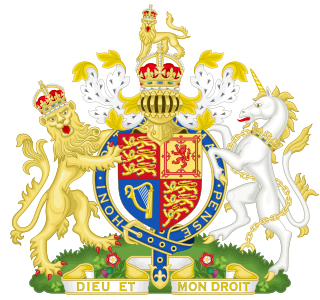
Heraldry is a discipline relating to the design, display and study of armorial bearings, as well as related disciplines, such as vexillology, together with the study of ceremony, rank and pedigree. Armory, the best-known branch of heraldry, concerns the design and transmission of the heraldic achievement. The achievement, or armorial bearings usually includes a coat of arms on a shield, helmet and crest, together with any accompanying devices, such as supporters, badges, heraldic banners and mottoes.

Baron is a rank of nobility or title of honour, often hereditary, in various European countries, either current or historical. The female equivalent is baroness. Typically, the title denotes an aristocrat who ranks higher than a lord or knight, but lower than a viscount or count. Often, barons hold their fief – their lands and income – directly from the monarch. Barons are less often the vassals of other nobles. In many kingdoms, they were entitled to wear a smaller form of a crown called a coronet.

The coat of arms of the United Kingdom, also referred to as the royal arms, are the arms of dominion of the British monarch, currently Charles III. They are used by the Government of the United Kingdom and by other Crown institutions, including courts in the United Kingdom and in some parts of the Commonwealth. Differenced versions of the arms are used by members of the British royal family. The monarch's official flag, the Royal Standard, is the coat of arms in flag form.

In British heraldry, a coronet is any crown whose bearer is less than sovereign or royal in rank, irrespective of the crown's appearance. In other languages, this distinction is not made, and usually the same word for crown is used irrespective of rank In this use, the English coronet is a purely technical term for all heraldic images of crowns not used by a sovereign, and implies nothing about the actual shape of the crown depicted. A Coronet is another type of crown, but is reserved for the lower ranks of nobility like Marquesses and Marchionesses, Earls and Countesses, Barons and Baronesses, and some Lords and Ladies. The specific design and attributes of the crown or coronet signifies the hierarchy and ranking of its owner.

Swedish heraldry encompasses heraldic achievements in modern and historic Sweden. Swedish heraldic style is consistent with the German-Nordic heraldic tradition, noted for its multiple helmets and crests which are treated as inseparable from the shield, its repetition of colours and charges between the shield and the crest, and its scant use of heraldic furs. Because the medieval history of the Nordic countries was so closely related, their heraldic individuality developed rather late. Swedish and Finnish heraldry have a shared history prior to the Diet of Porvoo in 1809; these, together with Danish heraldry, were heavily influenced by German heraldry. Unlike the highly stylized and macaronic language of English blazon, Swedish heraldry is described in plain language, using only Swedish terminology.

The coat of arms of Scotland, colloquially called the Lion Rampant, is the coat of arms historically used as arms of dominion by the monarchs of the Kingdom of Scotland, and later used within the coat of arms of Great Britain and the present coat of arms of the United Kingdom. The arms consist of a red lion surrounded by a red double border decorated with fleurs-de-lis, all on a gold background. The blazon, or heraldic description, is: Or a lion rampant Gules armed and langued Azure within a double tressure flory-counter-flory of the second.

Typical of British heraldry, a cap of maintenance, known in heraldic language as a chapeau gules turned up ermine, is a ceremonial cap of crimson velvet lined with ermine, which is worn or carried by certain persons as a sign of nobility or special honour. It is worn with the high part to the fore, and the tapering tail behind. It may substitute for the torse in the heraldic achievement of a person of special honour granted the privilege by the monarch. It thus appears in such cases on top of the helm and below the crest. It does not, however, feature in the present royal coat of arms of the United Kingdom, which shows the royal crest upon the royal crown, itself upon the royal helmet.

Portuguese heraldry encompasses the modern and historic traditions of heraldry in Portugal and the Portuguese Empire. Portuguese heraldry is part of the larger Iberian tradition of heraldry, one of the major schools of heraldic tradition, and grants coats of arms to individuals, cities, Portuguese colonies, and other institutions. Heraldry has been practiced in Portugal at least since the 12th century, however it only became standardized and popularized in the 16th century, during the reign of King Manuel I of Portugal, who created the first heraldic ordinances in the country. Like in other Iberian heraldic traditions, the use of quartering and augmentations of honor is highly representative of Portuguese heraldry, but unlike in any other Iberian traditions, the use of heraldic crests is highly popular.

Norwegian heraldry has roots in early medieval times, soon after the use of coats of arms first appeared in continental Europe. Some of the medieval coats of arms are rather simple of design, while others have more naturalistic charges. The king-granted coats of arms of later times were usually detailed and complex. Especially in the late 17th century and the 18th century, many ennobled persons and families received coats of arms with shields containing both two and four fields, and some even with an inescutcheon above these.

The tradition and art of heraldry first appeared in Spain at about the beginning of the eleventh century AD and its origin was similar to other European countries: the need for knights and nobles to distinguish themselves from one another on the battlefield, in jousts and in tournaments. Knights wore armor from head to toe and were often in leadership positions, so it was essential to be able to identify them on the battlefield.

The lion is a common charge in heraldry. It traditionally symbolises courage, nobility, royalty, strength, stateliness and valour, because historically the lion has been regarded as the "king of beasts". The lion also carries Judeo-Christian symbolism. The Lion of Judah stands in the coat of arms of Jerusalem. Similar-looking lions can be found elsewhere, such as in the coat of arms of the Swedish royal House of Bjälbo, from there in turn derived into the coat of arms of Finland, formerly belonging to Sweden.

Canadian royal symbols are the visual and auditory identifiers of the Canadian monarchy, including the viceroys, in the country's federal and provincial jurisdictions. These may specifically distinguish organizations that derive their authority from the Crown, establishments with royal associations, or merely be ways of expressing loyal or patriotic sentiment.

Canadian heraldry is the cultural tradition and style of coats of arms and other heraldic achievements in both modern and historic Canada. It includes national, provincial, and civic arms, noble and personal arms, ecclesiastical heraldry, heraldic displays as corporate logos, and Canadian blazonry.

English heraldry is the form of coats of arms and other heraldic bearings and insignia used in England. It lies within the so-called Gallo-British tradition. Coats of arms in England are regulated and granted to individuals by the English kings of arms of the College of Arms. An individual's arms may also be borne 'by courtesy' by members of the holder's nuclear family, subject to a system of cadency marks, to differentiate those displays from the arms of the original holder. The English heraldic style is exemplified in the arms of British royalty, and is reflected in the civic arms of cities and towns, as well as the noble arms of individuals in England. Royal orders in England, such as the Order of the Garter, also maintain notable heraldic bearings.

French heraldry is the use of heraldic symbols in France. Although it had a considerable history, existing from the 12th century, such formality has largely died out in France, as far as regulated personal heraldry is concerned. Civic heraldry on the other hand remains a visible part of daily life.

The Tudor Crown was a crown created in the early 16th century for either Henry VII or Henry VIII, the first Tudor monarchs of England, and destroyed in 1649 during the English Civil War. It was described by the art historian Sir Roy Strong as 'a masterpiece of early Tudor jeweller's art'.
A national coat of arms is a symbol which denotes an independent state in the form of a heraldic achievement. While a national flag is usually used by the population at large and is flown outside and on ships, a national coat of arms is normally considered a symbol of the government or the head of state personally and tends to be used in print, on armorial ware, and as a wall decoration in official buildings. The royal arms of a monarchy, which may be identical to the national arms, are sometimes described as arms of dominion or arms of sovereignty.

In heraldry, a mantle is a symbol of sovereign power and is generally reserved for royalty. In some cases, its use has also been granted to other nobles, in recognition of particular merits. In ordinary rendering, the mantle is usually crimson and lined with ermine.

The first instance of a figure of the lion as symbol of the Kingdom of León is found in minted coins of Alfonso VII, called the Emperor (1126–1157). Until then, the cross had a preponderant position on documents and coins of Leonese monarchs since that reign the cross was gradually displaced by the lion. The Spanish historian and heraldist Martín de Riquer explained that the lion was already used as heraldic emblem in 1148. At the end of the reign of Alfonso VII, the figure of this animal began to appear on royal documents as personal device of the monarch and became pervasive during reigns of Ferdinand II (1157-1188) and Alfonso IX (1188-1230).

The coat of arms of the Prince of Wales is the official personal heraldic insignia of the Princes of Wales, a title traditionally granted to the heir apparent of the reigning monarch of the United Kingdom of Great Britain and Northern Ireland, formerly the Kingdom of Great Britain and before that the Kingdom of England.



















































